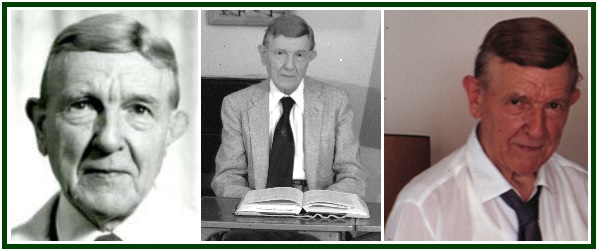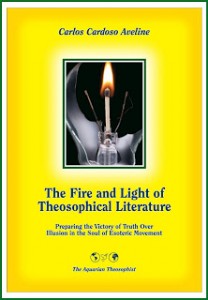
Why The Secret Doctrine Q. & A.
Deserves a Place in Everyone’s Library
Carlos Cardoso Aveline

Three photos of the author Geoffrey A. Barborka (1897-1982)
A commentary on the book “Secret Doctrine
Questions & Answers”, by Geoffrey A. Barborka,
Wizards Bookshelf, USA, 2003, 197 pp.
What actually reincarnates in us?
What is it that becomes an Initiate?
What is the difference between prana and animal magnetism?
Is there a limit to the number of incarnations in one Manvantara?
Questions lead us to study. They make us search. They widen our attention and stimulate our intuition. As time passes and we slowly grow in wisdom, we are able to give better answers to the same old, fundamental questions.
These are some of the reasons why philosophical questions are often more important than the answers we can provide them, and perhaps in some cases they are more significant than our present, limited understanding of the answers given by sages.
The ancient practice of questions and answers – intimately connected to the Socratic and Platonic methods of teaching – was employed in the 19th century by the Adept-Teachers that exchanged letters with lay disciples, as we can see in the “Mahatma Letters to A.P. Sinnett”. It was widely adopted by H.P. Blavatsky in “The Key to Theosophy”, in her “Conversations on Occultism” and other texts. The method can also be seen in the first volumes of the magazine “The Theosophist”, when HPB was its editor.
Following the same, well-established tradition, Geoffrey Barborka published between 1964 and 1980, in the bi-monthly periodical “The Canadian Theosophist”, a series of questions and answers about the book “The Secret Doctrine”, by H.P.B. In 2003, those 275 stimulating questions and answers were published in a hardcover book by Wizards Bookshelf, California.
The clear, documented answers make a long and illuminating conversation on the eternal truth and on the complex interaction linking each man to the universe. In order to sense the book’s flavour, it is worthwhile taking a look, for instance, at the discussion about planetary spirits and the seven chief or sacred Planets, on p. 25.
“Well, then, what are the Seven Sacred Planets?” – says a question. And Geoffrey Barborka answers:
“Here is the enumeration. First, a sacred planet for which the Sun is named as a substitute; then Jupiter; Venus; Saturn; Mercury; Mars; a sacred planet for which the Moon is named as a substitute.”
“But you have not included Uranus, Neptune and Pluto. Are not these ‘Sacred Planets’? Could these be included in the un-named planets?”
“No – to both questions. These three are not included in the enumeration of the Seven Sacred Planets of the ancients, in spite of their astrological importance.”
“Can you give the reason why they are not included as Sacred Planets; even though astronomers regard these three planets as pertaining to our solar system; and you have said that they do have an astrological significance?”
“In the Esoteric Philosophy Uranus, Neptune and Pluto are regarded as belonging to what may be termed as ‘the Universal Solar System’, instead of to the solar system over which our Sun has its regency. The reason that the seven enumerated planets are termed ‘Sacred’ is this: each one of the seven has an especial relationship to one globe in particular of the seven globes of the Earth-Chain, in that it acts in the capacity of a Regent during the building of that one particular globe of the Chain.”
“Can you name the Regency provided by the Seven Sacred Planets to the seven globes of the Earth-Chain?”
“Yes. The Sacred Planet having regency over Globe A during its formative period is the one for which the Sun is named as a substitute; Jupiter has regency over Globe B; Venus has regency over Globe C; Saturn and the Moon have regency over Globe D; Mercury has regency over Globe E; Mars has regency over Globe F; the planet for which the Moon is named as substitute has regency over Globe G.”
A well-known theosophist, Geoffrey Barborka (1897-1982) wrote several books, among them “The Divine Plan” (1961), “H.P. Blavatsky, Tibet and Tulku” (1966) and “The Story of Human Evolution” (1979). Richard Robb, the editor of SD Questions & Answers, writes about Barborka on page 186 of the volume:
“In temperament he was very reserved, and early on embraced a degree of asceticism, demonstrating extraordinary self-discipline with total commitment to his studies. He was seldom known to engage in casual conversation, remaining attentive and silent.”
Resulting from decades of study and work, “Secret Doctrine Questions & Answers” goes beyond the important tasks of explaining difficult passages in HPB’s work, inviting us to better study the Secret Doctrine or giving a general view of the esoteric philosophy.
Helpful to both new and old students, this inspiring book offers us a fluent, fascinating dialogue on the law of the universe, on the ways of its eternal life and – last but not least – on the process and cycles of each man’s evolution.
000
An initial version of the above article was published at “The Aquarian Theosophist”, in its Special Issue of August 2005, pp. 8-10. Original title: “A Conversation on the Eternal Truth”.
000
On the role of the esoteric movement in the ethical awakening of mankind during the 21st century, see the book “The Fire and Light of Theosophical Literature”, by Carlos Cardoso Aveline.

Published in 2013 by The Aquarian Theosophist, the volume has 255 pages and can be obtained through Amazon Books.
000